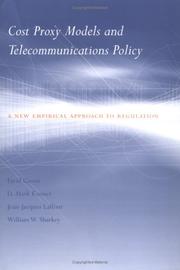| Listing 1 - 10 of 57 | << page >> |
Sort by
|

ISBN: 0262275635 0585436134 9780262275637 9780585436135 9780262082983 0262082985 Year: 2001 Publisher: Cambridge, Mass. MIT Press
Abstract | Keywords | Export | Availability | Bookmark
 Loading...
Loading...Choose an application
- Reference Manager
- EndNote
- RefWorks (Direct export to RefWorks)
"By 1897 Guglielmo Marconi had transformed James Clerk Maxwell's theory of electromagnetic waves into a workable wireless telegraphy system, and by 1907 Lee de Forest had invented the audion, a feedback amplifier and oscillator that opened the way to practical radio transmission. Fifteen years after Marconi's invention, wireless had become an essential means of communication, as well as a hobby for many. This book offers a new perspective on the early days of wireless communication. Drawing on previously untapped archival evidence and recent work in the history and sociology of science and technology, it examines the substance and context of both experimental and theoretical aspects of engineering and scientific practices in the first years of this technology. It offers new insights into the relationship between Marconi and his scientific advisor, the physicist John Ambrose Fleming (inventor of the vacuum tube). It includes the full story of the infamous 1903 incident in which Marc ni's opponent Nevil Maskelyne interfered with Fleming's public demonstration of Marconi's syntonic (tuning) system at the Royal Institution by sending derogatory messages from his own transmitter. The analysis of the Maskelyne affair highlights the struggle between Marconi and his opponents, the efficacy of early syntonic devices, Fleming's role as a public witness to Marconi's private experiments, and the nature of Marconi's "shows." It also provides a rare case study of how the credibility of an engineer can be created, consumed, and suddenly destroyed. The book concludes with a discussion of de Forest's audion and the shift from wireless telegraphy to radio."
Book
Year: 2015 Publisher: Cambridge, Massachusetts : The MIT Press,
Abstract | Keywords | Export | Availability | Bookmark
 Loading...
Loading...Choose an application
- Reference Manager
- EndNote
- RefWorks (Direct export to RefWorks)
"The emergence of cloud computing marks the moment when computing has become, materially and symbolically, infrastructure -- a sociotechnical system that is ubiquitous, essential, and foundational. Increasingly integral to the operation of other critical infrastructures, such as transportation, energy, and finance, it functions, in effect, as a meta-infrastructure. As such, the cloud raises a variety of policy and governance issues, among them market regulation, fairness, access, reliability, privacy, national security, and copyright. In this book, experts from a range of disciplines offer their perspectives on these and other concerns. The contributors consider such topics as the economic implications of the cloud's shifting of computing resources from ownership to rental; the capacity of regulation to promote reliability while preserving innovation; the applicability of contract theory to enforce service guarantees; the differing approaches to privacy taken by United State and the European Union in the post-Snowden era; the delocalization or geographic dispersal of the archive; and the cloud-based virtual representations of our body in electronic health data."
Book
ISBN: 9780262535083 9780262346191 0262346192 0262535084 0262346206 Year: 2018 Publisher: Cambridge, MA : The MIT Press,
Abstract | Keywords | Export | Availability | Bookmark
 Loading...
Loading...Choose an application
- Reference Manager
- EndNote
- RefWorks (Direct export to RefWorks)
Interdisciplinary perspectives on the role of new information technologies, including mobile phones, wireless networks, and biometric identification, in the global refugee crisis.
Book
ISBN: 9780262027861 0262027860 1322110719 0262529890 0262319802 9780262319805 9780262529891 0262319810 Year: 2014 Publisher: Cambridge : MIT Press,
Abstract | Keywords | Export | Availability | Bookmark
 Loading...
Loading...Choose an application
- Reference Manager
- EndNote
- RefWorks (Direct export to RefWorks)
Webster describes factors that create audiences, including preferences and habits of media users, the role of social networks, the resources and strategies of media providers, and the growing impact of media measures--from ratings to user recommendations. He shows that the marketplace works in ways that belie our greatest hopes and fears about digital media and shows that public attention is at once diverse and concentrated--that users move across a variety of outlets, producing high levels of audience overlap. He questions whether our preferences are immune from media influence, and he describes how our encounters with media might change our tastes. Webster claims we typically encounter ideas that cut across our predispositions. In the process, we will remake the marketplace of ideas and reshape the twenty-first century public sphere. --
Médias --- Mass media --- Publics --- Audiences. --- Audiences --- E-books --- Audiences, Mass media --- Social aspects --- Publics. --- INFORMATION SCIENCE/Communications & Telecommunications --- PHYSICAL SCIENCES/General --- SCIENCE, TECHNOLOGY & SOCIETY/General --- Médias
Book
ISBN: 9780262016643 9780262298476 0262016648 0262298473 1283448874 9781283448871 9786613448873 0262297582 Year: 2011 Publisher: Cambridge, Massachusetts : MIT Press,
Abstract | Keywords | Export | Availability | Bookmark
 Loading...
Loading...Choose an application
- Reference Manager
- EndNote
- RefWorks (Direct export to RefWorks)
In making decisions, we often seek advice. Online, we check Amazon recommendations, eBay vendors' histories, TripAdvisor ratings, and even our elected representatives' voting records. These online reputation systems serve as filters for information overload. In this book, experts discuss the benefits and risks of such online tools. The contributors offer expert perspectives that range from philanthropy and open access to science and law, addressing reputation systems in theory and practice. Properly designed reputation systems, they argue, have the potential to create a "reputation society," reshaping society for the better by promoting accountability through the mediated judgments of billions of people. Effective design can also steer systems away from the pitfalls of online opinion sharing by motivating truth-telling, protecting personal privacy, and discouraging digital vigilantism.
Book
ISBN: 0262331314 9780262331319 9780262029735 9780262331326 0262331322 9780262331302 0262331306 0262029731 Year: 2015 Publisher: Cambridge MIT Press
Abstract | Keywords | Export | Availability | Bookmark
 Loading...
Loading...Choose an application
- Reference Manager
- EndNote
- RefWorks (Direct export to RefWorks)
With Obfuscation, Finn Brunton and Helen Nissenbaum mean to start a revolution. They are calling us not to the barricades but to our computers, offering us ways to fight today's pervasive digital surveillance -- the collection of our data by governments, corporations, advertisers, and hackers. To the toolkit of privacy protecting techniques and projects, they propose adding obfuscation: the deliberate use of ambiguous, confusing, or misleading information to interfere with surveillance and data collection projects. Brunton and Nissenbaum provide tools and a rationale for evasion, noncompliance, refusal, even sabotage -- especially for average users, those of us not in a position to opt out or exert control over data about ourselves. Obfuscation will teach users to push back, software developers to keep their user data safe, and policy makers to gather data without misusing it.Brunton and Nissenbaum present a guide to the forms and formats that obfuscation has taken and explain how to craft its implementation to suit the goal and the adversary. They describe a series of historical and contemporary examples, including radar chaff deployed by World War II pilots, Twitter bots that hobbled the social media strategy of popular protest movements, and software that can camouflage users' search queries and stymie online advertising. They go on to consider obfuscation in more general terms, discussing why obfuscation is necessary, whether it is justified, how it works, and how it can be integrated with other privacy practices and technologies.
Book
ISBN: 0262034417 9780262034418 9780262332392 0262332396 026233240X Year: 2016 Publisher: Cambridge, MA : The MIT Press,
Abstract | Keywords | Export | Availability | Bookmark
 Loading...
Loading...Choose an application
- Reference Manager
- EndNote
- RefWorks (Direct export to RefWorks)
The horse racing industry has been a pioneer in interactive media, information networks, and their deployment. The race track and the off-track betting parlor offer interactive media environments that reconfigure the relationships among private and public space and presence and copresence. In this book, Holly Kruse explores how horse racing has used media over the last several decades, arguing that examining the history and context of horse racing and gambling gives us a clearer understanding of the development of data networks, media complexes, public entertainment, and media publics. Kruse describes an enormous industry that depends on global information and communication flows made possible by a network linking racetracks, homes, off-track betting, farms, and auction sites. Racetrack architecture now allows for the presence of screens, most showing races from other locations. Online betting sites enable bettors to wager from home. Off-track betting facilities collect wagers on races from all over the country. Odds are set interactively through the pari-mutuel market system. Kruse considers the uses of public space, and its redefinition by public screens; the effect of interactive media on the racing industry, including networked, in-home betting; the "technopanic" over online poker and the popularity of in-home pari-mutuel wagering; and the use of social media by racing fans to share information and creative work with no financial payoff.
Horse racing --- Betting --- Information technology. --- Computer networks. --- INFORMATION SCIENCE/Communications & Telecommunications --- SOCIAL SCIENCES/Media Studies --- Flat racing --- Horseracing --- Horse sports --- Racing --- Race horses
Book
ISBN: 9780262331227 0262331225 9780262528207 0262528207 9780262029889 026202988X 0262331233 Year: 2016 Publisher: Cambridge, MA
Abstract | Keywords | Export | Availability | Bookmark
 Loading...
Loading...Choose an application
- Reference Manager
- EndNote
- RefWorks (Direct export to RefWorks)
Behind-the-scenes stories of how Internet research projects actually get done.The realm of the digital offers both new methods of research and new objects of study. Because the digital environment for scholarship is constantly evolving, researchers must sometimes improvise, change their plans, and adapt. These details are often left out of research write-ups, leaving newcomers to the field frustrated when their approaches do not work as expected. Digital Research Confidential offers scholars a chance to learn from their fellow researchers' mistakes--and their successes. The book--a follow-up to Eszter Hargittai's widely read Research Confidential--presents behind-the-scenes, nuts-and-bolts stories of digital research projects, written by established and rising scholars. They discuss such challenges as archiving, Web crawling, crowdsourcing, and confidentiality. They do not shrink from specifics, describing such research hiccups as an ethnographic interview so emotionally draining that afterward the researcher retreated to a bathroom to cry, and the seemingly simple research question about Wikipedia that mushroomed into years of work on millions of data points. Digital Research Confidential will be an essential resource for scholars in every field.ContributorsMegan Sapnar Ankerson, danah boyd, Amy Bruckman, Casey Fiesler, Brooke Foucault Welles, Darren Gergle, Eric Gilbert, Eszter Hargittai, Brent Hecht, Aron Hsiao, Karrie Karahalios, Paul Leonardi, Kurt Luther, Virag Molnar, Christian Sandvig, Aaron Shaw, Michelle Shumate, Matthew Weber

ISBN: 0262072378 0262273586 0585448361 9780262273589 9780585448367 9780262072373 Year: 2002 Volume: 22 Publisher: Cambridge, Mass. : MIT Press,
Abstract | Keywords | Export | Availability | Bookmark
 Loading...
Loading...Choose an application
- Reference Manager
- EndNote
- RefWorks (Direct export to RefWorks)
An empirical approach to understanding telecommunications regulation based on the use of a sophisticated engineering cost proxy model.The telecommunications industry defies easy characterization. The long-distance sector is highly competitive and the local exchange sector much less so, while digital transmission and switching have blurred the distinction between traditional voice communication and the transmission of video and data messages. Regulation of this industry has generally been considered necessary because it has aspects of a natural monopoly.This book takes an empirical approach to natural monopoly and the need for regulation of telecommunications. The centerpiece of the analysis is a sophisticated engineering cost proxy model, the local exchange cost optimization model (LECOM). The book, which is largely methodological, shows that a combination of LECOM, econometrics, and simulations can aid policy discussion of such contentious issues as incentive regulation, natural monopolies, estimating the cost of interconnection among networks, and the obligation of universal service. The book presents a theoretical framework to explain the incentives of firms and the power of regulation and then uses LECOM to test the theoretical implications. The work is unusual in that it applies the foundations of regulation theory to a model of an industry rather than applying econometric theory to historical cost data. The book includes a CD-ROM containing the data set the authors used to analyze their model.
Telecommunication --- Telecommunication policy --- Law and legislation --- Costs --- Econometric models. --- Electric communication --- Mass communication --- Telecom --- Telecommunication industry --- Telecommunications --- Costs&delete& --- Econometric models --- E-books --- Communication --- Information theory --- Telecommuting --- ECONOMICS/Industrial Organization --- INFORMATION SCIENCE/Communications & Telecommunications

ISBN: 0262033143 0262270943 0585479836 9780262270946 9780585479835 9780262033145 0262262169 9780262262163 Year: 2003 Publisher: Cambridge, Mass. : MIT Press,
Abstract | Keywords | Export | Availability | Bookmark
 Loading...
Loading...Choose an application
- Reference Manager
- EndNote
- RefWorks (Direct export to RefWorks)
The contributors to this volume examine issues raised by the intersection of new communications technologies and public policy in this post-boom, post-bust era. Originally presented at the 30th Research Conference on Communication, Information, and Internet Policy (TPRC 2002)--traditionally a showcase for the best academic research on this topic--their work combines hard data and deep analysis to explore the dynamic interplay between technological development and society. The chapters in the first section consider the ways society conceptualizes new information technologies and their implications for law and policy, examining the common metaphor of "cyberspace as place," alternative definitions of the Internet, the concept of a namespace, and measures of diffusion. The chapters in the second section discuss how technological change may force the rethinking of legal rights; topics considered include spectrum rights, intellectual property, copyright and "paracopyright," and the abridgement of constitutional rights by commercial rights in ISP rules. Chapters in the third and final section examine the constant adjustment and reinterpretation of regulations in response to technological change, considering, among other subjects, liability regimes for common carriers and the 1996 detariffing rule, privacy and enhanced 911, and the residual effect of state ownership on privatized telecommunication carriers. The policy implications of Rethinking Rights and Regulations are clear: major institutional changes may be the necessary response to major advances in telecommunications technology.
Information society --- Telecommunication policy --- Internet --- Information technology --- Government policy --- Social aspects --- Management --- DARPA Internet --- Internet (Computer network) --- Wide area networks (Computer networks) --- World Wide Web --- E-books --- INFORMATION SCIENCE/Technology & Policy --- INFORMATION SCIENCE/Communications & Telecommunications
| Listing 1 - 10 of 57 | << page >> |
Sort by
|

 Search
Search Feedback
Feedback About UniCat
About UniCat  Help
Help News
News